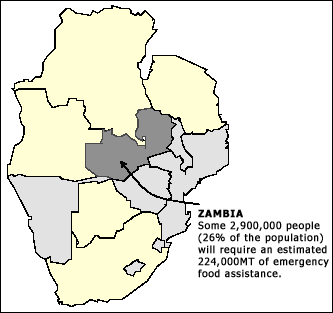
|
Zambia National Vulnerability Assessment Committee
in collaboration with the SADC FANR Vulnerability Assessment Committee
Zambia Emergency Food Security Assessment Report
16 September 2002 - Lusaka
Prepared with financial support from DFID, WFP and USAID
|
Contact details Mr R Mugwara:
rmugwara@sadcfanr.org
SARPN acknowledges permission from the Food, Agriculture and Natural Resources Vulnerability Assessment
Committee to post this series of documents
|
|
|
|
[Download complete document  - 1.4Mb ~ 8 min (28 pages)]
[ Share with a friend - 1.4Mb ~ 8 min (28 pages)]
[ Share with a friend  ]
]
|

|
PREFACE
This emergency food security assessment is regionally coordinated by the Southern Africa
Development Community (SADC) Food, Agriculture, and Natural Resources (FANR) Vulnerability
Assessment Committee (VAC), in collaboration with international partners (WFP, FEWS NET,
SC(UK), CARE, FAO, UNICEF, and IFRC). National VACs in each country--a consortium of
government, NGO, and UN agencies—coordinated the assessments locally. This is the first of a
series of rolling food security assessments to be conducted in affected countries throughout the
region for the duration of the current food crisis.
The VAC assessment strategy has two principal axes. First, it uses a sequential process of ‘bestpractices’
in assessment and monitoring, drawn from the extensive and varied experience of the
VAC partners, to meet a broad range of critical information needs at both the spatial and socioeconomic
targeting levels. The sequential nature of the approach not only provides richer details
of the "access side" of the food security equation, but it adds the very important temporal
dimension as well. From an operational (i.e. response) perspective, the latter is critical. Second,
by approaching food security assessment through a coordinated, collaborative process, the
strategy integrates the most influential assessment and response players into the ongoing effort,
thereby gaining privileged access to national and agency datasets and expert technicians and
increases the likelihood of consensus between national governments, implementing partners, and
major donors. This ‘partnering’ strategy links the major players and stakeholders including regional
institutions, national governments, response agencies, NGOs and donors for on-going, intensive
‘rolling’ assessment coverage of food security conditions on the ground.
|
[Download complete document  - 1.4Mb ~ 8 min (28 pages)] - 1.4Mb ~ 8 min (28 pages)]
|
|






